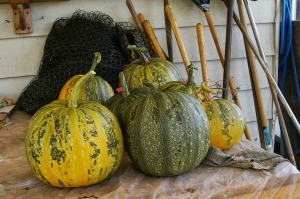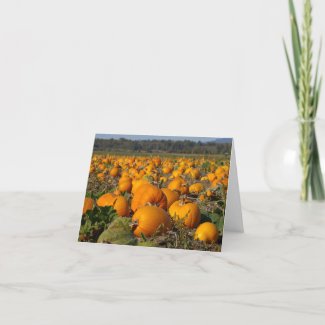Pumpkin seed oil as a cash crop
Copyright National Lilac Publishing, LLC. A version of this article by Barbara Berst Adams was first published in AcresUSA Magazine.
Wisconsin farmers produce high quality organic pumpkin seed oil
A variety of culinary oil crops grow on farms in the USA besides soybeans, including safflowers, peanuts, sunflowers, corn, olives and others. And now, there’s a new oil on the block. The North American species of pumpkin used for oil has entered the scene as a healthy, sustainable oil crop, and one that grows well in many temperate climates. Native American pumpkins did have to first travel to Europe via Christopher Columbus, though, for their seeds to eventually become used as oil producers on a noticeable scale. Since then, Austria has become especially known as a producer of fine pumpkin seed oil.
But oilseed pumpkins have returned to the USA as an food oil crop. University studies have shown promising nutritional attributes of properly processed pumpkin seed oil, including its content of Omega 3 fatty acids. The seeds of specific pumpkin varieties produce seeds without husks, or hulls, and are usually the type of seed used to produce the oil. Many have seen these hulless pumpkin seeds sold as healthy snacks. Eventually, two aspiring USA farmers took notice of the promise of these pumpkins as oil crops.
After discovering an affinity for pumpkin seed oil, Ken Seguine and Jay Gilbertson founded Hay River Pumpkin Seed Oil on their acreage in Prairie Farm, Wisconsin. They’ve embarked on their pumpkin seed oil project to not only produce their own value-added crop, but to enhance their local economy and cooperate with other nearby farmers as well. Currently, they produce certified organic cold-pressed pumpkin seed oil which they sell to various food markets in about nine states across the country, including their own state of Wisconsin.
The farm’s beginnings
Many years ago before Seguine was involved in farming, he worked for the beauty product company, Aveda, and attended trade shows where Austrian venders shared complimentary bottles of pumpkin seed oil. He found the oil to be quite delicious. As his interest in sustainability, local economies and rural living grew, he and novelist Jay Gilbertson moved to 80 acres in northwest Wisconsin. While seeking possible niche farm products to grow, they attended an agricultural conference where oilseed crops were suggested, and they chose pumpkins. After four years of trialing various hulless seeded pumpkins to see which produced best in their area, their pumpkin seed oil adventure moved forward. Today, Hay River Pumpkin Seed Oil is a popular item both locally and across the country.
They
have chosen to formally name their oil product, but not their farm. “We
do not have a farm name. We just call it “the farm” when we refer to
it, or “home” when we are talking to each other,” Seguine said. Their
property lies within USDA plant hardiness zone 4a. In this area of
Wisconsin, frosts can come late, so they start their pumpkins in their
greenhouse in spring before planting them out in the fields. After
hopefully a healthy season of growth, the pumpkins are harvested in
fall. The farmers have experimented with both hand harvesting and
mechanical harvesting, and have concentrated over the years on improving
this area of the farm’s production. “We started off hand harvesting,”
Sequine said, “but switched to mechanical in 2010 with custom made
equipment. We then switched to European made equipment in 2013, which is
much faster. Pumpkins are hand picked up in the field and tossed into
the equipment. Cleaned seeds are then loaded out of the equipment for
drying.”
Once the seeds have been dried in custom-built equipment, they’re bagged to be transported to where they’ll be pressed for oil in Spooner, Wisconsin about an hour north of their farm.
Processing oil from seeds
The company that presses their oil in Spooner is Botanic Innovations, LLC. They press the seeds with German-made Komet equipment. Their process for pressing uses no chemicals and extracts oil using cool enough temperatures for the oil to be considered cold-pressed. Although it’s easy to assume “cold-pressed” means literally using only cold temperatures, some warmth can be generated from the pressing or grinding, and the process allows up to a certain temperature to still be considered cold-pressed. Several sources, including European ones, report that in order to be cold-pressed, temperatures used in the pressing or extraction process shouldn’t reach higher than 120°F (49°C). However, regulations vary from location to location, and opinions vary as well. As far as labeling in the USA, according to Al Kurki, Program Specialist for National Center for Appropriate Technology's ATTRA (The National Sustainable Agriculture Information Service) project, the USA doesn’t currently have an oil standard/temperature threshold for what can be labelled ‘cold-pressed.’ “Research here in Montana shows that the extraction efficiency drops considerably at temperatures below 170°F, particularly with small oilseeds,” he said. Higher heat definitely makes oil extraction easier and more productive, so it can be a challenge to find ways to process oil from seeds at lower temperatures. But, there are still USA oil producing companies that can extract oil at lower temperatures. Kurki confirms, for example, that The Oil Barn, a Montana farm that produces organic high-oleic safflower oil, uses European standards of temperature to produce their oil.
And for Hay River Pumpkin Seed Oil, according to Mark Mueller, founder and chief technology officer of Botanic Innovations, LLC, lower temperatures are maintained there, also. “We have a proprietary cold extraction process called NatureFRESH Cold Press. With this process, oils are extracted from the seed typically in a range of 90° F to 100° F.”
As far as pumpkin seeds go, though, flavor can be enhanced with the higher heat used in roasting as anyone who’s roasted jack-o-lantern pumpkin seeds in the oven has experienced. And at Botanic Innovations, LLC, Mueller reports that the seeds are very briefly exposed to a higher temperature before pressing. “In the case of the Hay River Pumpkin Seed Oil,” he said, “the seed is given what is considered a light toast. The seed is exposed to heat of approximately 300° F. The exposure of the seed to heat is very short, that is about one second or less. The light toast enhances the flavor. In a study we conducted, the light toasting does not harm stability or antioxidant activity.”
Seguine
further explained how the process of the quick high heat exposure works
with retaining cold-pressed qualities. “A heat collar is applied to the
tube that feeds the chamber where the seeds are pressed. The (higher)
temperature is not exact as the seeds flow past, but it’s a brief
exposure. Heat exposure is a matter of time. If it is brief it’s okay,
but sustained high temperatures will cause the oil to smoke and you will
destroy the Omega 3 content and damage the antioxidant carotenoids.”
Once the seeds are passed quickly through the higher heat, they are compressed and the resulting oil is forced through a fine mesh screen into a large drum. The oil is allowed to clarify for four to six weeks before it’s poured into individual bottles. The pumpkin seed meal that remains after the pressing is then sold to a beverage and nutritional food bar company.
Seguine stated that the resulting healthy oil is best not used for cooking that exposes it to high temperatures over a long time. The smoke point (the temperature at which an oil’s beneficial qualities begin to diminish because of heat) for cold-pressed pumpkin seed oil has been reported from various sources as between 150° F. to 250° F.
“The oil has a low smoke point and is a dark red color due to the very high antioxidant content, particularly lutein and the rare zeaxanthin,” Seguine said. However, the farmers report that it can be added to soups, and even used in scrambled eggs when another fat such as butter is used in the pan for cooking. The pumpkin seed oil is added in with the raw scrambled egg mixture upfront, then the mixture is cooked briefly. “Combining the oil with another fat (such as butter) also raises the smoke point,” Sequine said.
Marketing
The farmers have used a variety of methods for marketing, but both their online presence and eventual word of mouth played important marketing roles during various stages of their business. “From day one we sold on the web,” Seguine said. “Pumpkin seed oil was a relatively unsearched term and we put a lot of effort in the early days on our website. Because of that, we regularly showed up near the top of Google searches.
"These days there are many more players and frankly, we’ve just not put the work into the website we used to. Retailers in the natural channel are always looking for authentic, real products and after some early marketing efforts, it was word of mouth. At some point at the beginning you’ve got to pick up the phone and go dialing for dollars. You need to tell your story to get things going. Although we barely participate, social media is important now. Facebook is very important for all natural brands.”
Where they are going from here
Other area farmers currently grow oilseed pumpkins for the farm, and it’s a practice the owners hope will continue and expand. As well, along with providing another stream of income for other area farmers, Seguine and Gilbertson want to carry on with their support of the local economy by continuing to offer fair wages to hired farm crews.
Pumpkins served as a staple food crop for Native Americans for centuries. The crop then traveled far and wide to be adapted into the diets of people worldwide. The Cinderella pumpkin even became the European inspiration for the famous fairy tale. And now, thanks to the owners of Hay River Pumpkin Seed Oil, the USA can experience the flavorful and healthy oil product of the seeds of this adaptable native winter squash.
_____
At home small-scale pumpkin seed oil production
Homesteaders may be interested in growing pumpkin seeds for home production of pumpkin seed oil for their own use. Also, market farmers may want to experiment on a very small scale to determine if it’s a value-added crop they want to eventually expand to a larger scale.
The
challenge with pressing oil from various crops such as seeds or olives
is that oil extraction isn’t as simple as grinding a crop like grain to
produce flour, or pressing vegetables and fruits to produce juice,
especially when low heat is desired.
Oil extraction obviously has happened for centuries, but it can take enormous pressure -- such as that from large stone presses or mechanized presses -- to obtain the oil from a crop unless added heat is used to aid in the process. Keeping in mind that the term cold-pressed still allows a low amount of heat to be used, or even a brief amount of time at higher temperatures, many people who are interested in sustainably produced fresh oil prefer their product to meet or exceed cold-pressed temperature standards and to not be warmed up to an excessive temperature for more than a brief time, if at all.
Still,
opinions vary on the temperature and length of time regarding heat
exposure and the diminishing of oil quality. Homesteaders may want to
experiment or do further research on some of the at-home press options
available.
Currently, there is at least one hand turned tabletop seed oil extractor made in the Netherlands. Called the Piteba oil expeller (www.piteba.com) it’s made to be used without electricity. It does, however, come with the ability to apply heat during the seed pressing with a candle, so the oil extraction is easy to do and more oil is produced. It was stated by Lehman’s, www.lehmans.com, which sells the product in the US, that extracting oil without the candle to provide heat is possible with this device, but extremely difficult and that oil production falls markedly. They also state they don’t have data on the actual temperature the candle heats the extracted oil to, nor for how long the seeds or oil are exposed to that heat, but it’s assured by this seller that the oil becomes warmer than what would be considered cold-pressed. The makers of the Piteba press do state that gentler warmth, such as seeds warmed by being placed in the sun in a plastic bag, may be able to be pressed for oil without heating the oil extractor itself if the seeds are placed in and processed while still warm. Eventually, also, additional warmth will then be generated by the the extraction process. Homesteaders may want to experiment with these variables.
There is another foreign made manual pumpkin seed oil extractor made by Anyang General International Co., Ltd. (Agico), although research confirms it also uses heat to process the oil.
For do-it-yourselfers, journeytoforever.org offers instructions written back in the 1970s for a homemade sunflower seed oil press that they might want to try adapting to pumpkin seeds. The instructions also describe just how much heat is actually used to warm up the seeds for oil pressing with this homemade device, and the author offers readers his own very different opinion on how much warmth causes changes in the fatty acid structure of the oil, believing that this device does not exceed that amount of heat (keeping in mind he speaks of sunflower seeds, not pumpkin seeds, and that the article was written before other more recent research was conducted on the topic). See https://journeytoforever.org/biofuel_library/oilpress.html
Also, Will Bonsall of the Scatterseed Project (see "obtaining seeds" below), describes how he simply uses his own home grown pumpkin seed meal without extracting oil as a replacement for oil in various culinary dishes. See https://www.mofga.org/Publications/MaineOrganicFarmerGardener/Winter20122013/OilseedPumpkins/tabid/2451/Default.aspx
_____
Choosing and obtaining seeds for growing oilseed pumpkins
After Christopher Columbus brought American pumpkins to Europe, they became popular for a variety of uses, including obtaining oil from Cucurbita pepo seeds in European areas too cold to produce olives for oil. Will Bonsall of Industry, Maine, is the director of the Scatterseed Project, which is a genetic conservation enterprise that includes, among other things, saving open-pollinated seed varieties. According to Bonsall, pumpkin seed oil pressing was going on with farmers in Eastern Europe for centuries, when around 1870 an unusual trait arose where some pumpkins produced seeds with greatly reduced seed coats, essentially having no hulls. Bonsall states that made the oil pressing far easier and that the naked seeds are 40 to 50 percent oil.
Since then, both amateur and university breeding projects continue to work with the recessive gene in oilseed Cucurbita pepo for gardeners and farmers, and there are many varieties across the globe. The taste of the seeds varies, also. All are open-pollinated according to Bonsall.
Oilseed pumpkins range from varieties that produce partial husks to those that have virtually no husk at all. The mature pumpkins themselves are smaller than Cucurbita maxima -- the very large pumpkins used for carving jack-o-lanterns, although there are Cucurbita pepo varieties that make interesting autumn ornamentals. Some growers observe that in order to get the best seeds for oil in our country today, the qualities of tasty pumpkin flesh are usually sacrificed (and visa versa), at least with the more common hulless varieties offered in the US. Hulless varieties from other countries, though, may some day allow US growers to obtain high quality oilseeds along with superior tasting pumpkin flesh from the same variety.
Today in the USA, growers can hunt through various seed suppliers for hulless seeded pumpkin choices that may grow well in their climate. But while there are numerous varieties outside of the US, the current choices within the country aren’t many. “I don't know of any single company that carries more than one hulless seed pumpkin variety; there are few enough that offer any,” Bonsall said. “The main varieties on the US market are Lady Godiva, Styrian -- that's a generic; there are several of the Styrian type -- and Kokai, none of which are superior.” As another example, Baker Creek Heirloom Seeds offers Scheherazade Squash, which they claim was developed as an oilseed pumpkin.
“There are a lot of very superior varieties from other countries which are not in the US market,” Bonsall said. “I've been trialling a number of accessions from Eastern Europe and Turkey, some of which have really tasty flesh and at least seem to have an extremely hard and thick shell (on the pumpkin itself, not the seed) which I think could be dried and used as a decorative container, like a big gourd. However it may be awhile yet before I can get them selected and to the point where they can be commercially offered here.”
You may also enjoy
Pumpkin farming: Growing a pumpkin and autumn ornamental patch for profit
The Cinderella Pumpkin -- Its history, and growing it yourself











